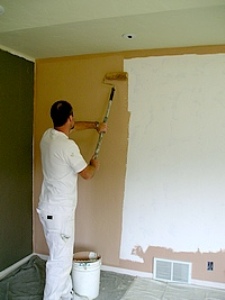Any finishing material should have a good hold on the surface - whether it is made of wood, metal, concrete or anything else. Improve the adhesion surface can be coated with a primer, the use of which has many advantages. Paint, plaster and other materials are better absorbed into the surface, resulting in stronger hold on her.
Despite this, some builders prefer to abandon the primer the walls, thereby increasing the risk that the plaster falls off, and wallpaper otvisnut. In addition, priming the walls prevents the final result of various defects (stains, cracks, divorce), arising from the moisture of the surface. So do not be lazy and Primary coated surface than to redo all the work to finish again. If you order a priming wall resolutely from the pros, it will cost you about 0.5 dollars per square meter of surface. Given that the cost per square meter of all the work required to finish the surface, is approximately $ 20, it is absurd not to give up the most expensive operation, lack of which could negate all the work.
If earlier for each type of work used the same type of primer, but now the building materials market has become more wealthy. You can buy any kind of primer, including, in particular, dry and ready to go. Primers differ in the type of surface, for which they are intended (wood, concrete, metal, plaster, brick), the level of the room humidity which will take work, and the method further finishing (tiling, painting, plastering). Also release formulations are designed for initial training bases (primer-primer) and to improve the attachment between finishing coats.
The structure includes a variety of film-forming primers matter (bitumen, tar, some glue, oils), pigments, and accelerators are dry. They are made in acrylic, mineral, alkyd and other basics.
Primers based on mineral oil used for the initial rapid processing and surfacing of mineral materials: brick, concrete, lightweight concrete, plasters, silicate-concrete blocks. As an element of cohesion in these soils is used cement.
At the present time are very popular universal water based primers, acrylic-based copolymers. They are able to create a good grip on any surface, including latex, acrylic and alkyd paints. These primers can be used on the surfaces of concrete, cement, covered with plaster, plasterboard walls, covered with paint and finished with glass fiber wallpaper.
Primers quick drying alkyd based used for primary and secondary finishing of wood, wood fiber and particle board - as has already been dyed and untreated. These soils are well attached, even to such surfaces as PVC plastic, glass, galvanized steel, fiberglass.
Among the specialized primers may be noted 1) vlagoizolyatsionnye primers that contain additives and fungicidal protivoplesnevye, 2) special insulating ground, opposing the appearance of defects on the walls due to nicotine, smoke, soot, and 3) are designed for ceilings, 4) for the pre-treatment of the sexes.
